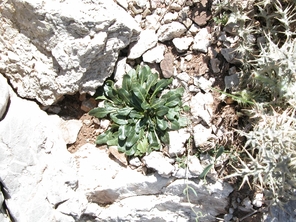Beta macrohiza. Photo: L. Frese
Grant Scheme Activity
| Fourth/Fifth Call (2017) | |
| First Call (2014) |
Working Group activities and related events
October 2018
Research article on Patellifolia published online
- Frese L, Nachtigall M, Iriondo J.M. et al. 2018. Genetic diversity and differentiation in Patellifolia (Amaranthaceae) in the Macaronesian archipelagos and the Iberian Peninsula and implications for genetic conservation programmes. Genetic Resources Crop Evolution https://doi.org/10.1007/s10722-018-0708-4. To access directly the full paper in PDF format, click here.
June 2018
The BETANET meeting took place 19-20 June 2018 at San Servolo, Venice, Italy [more info]
January 2018
The project on “Improving a cooperation network between actors involved in conservation and utilization of Beta genetic resources (BETANET)" will hold a meeting 19-20 June 2018 at Venice, Italy.
October 2017
The project on “Improving a cooperation network between actors involved in conservation and utilization of Beta genetic resources (BETANET)", submitted by the Beta Working Group for funding under the Fourth Call of the ECPGR Activity Grant Scheme and re-submitted as requested under the Fifth Call, was selected by the Executive Committee. [more info]
July 2017
“Genetic diversity of Patellifolia species (GeDiPa)”: the Final Activity Report is now available online [here].
June 2017
Innovative breeding research project underpins the value of genetic reserves
(A note by Lothar Frese and Gina Capistrano-Gossmann)
“Crop wild relative populations of Beta vulgaris allow direct mapping of agronomically important genes” is the title of a paper recently published in Nature Communications (Capistrano-Gossmann et al. 2017). The researchers used two CWR populations of Beta vulgaris subsp. maritima for fine mapping and rapid identification of a Rhizomania resistance gene. [read more] (38,5 KB)

January 2017
Update on Beta nana studies
Little was known about the conservation status and properties of Beta nana in 1993 as noted in the Greek report presented at the 3rd International Beta Genetic Resources Workshop held at the North Dakota State University, Fargo, USA. Since then B. nana stayed on the agenda of the Working Group which recommended in 1999 to include B. nana into in situ conservation projects. It took five years to organize a B. nana plant exploration mission which allowed a team of US-American, Greek and German experts to collect research material in 2005. Seed increase of the collected germplasm followed and in parallel the search for polymorphic microsatellite marker began. In addition, the Greek Genebank implemented two other missions in 2007 and in 2012 on Olympus Mountain for monitoring and recording the demographic parameters of the target populations, which were accompanied by field observations and measurements of the ecological environment. The investigation of the genetic population structure in the alpine B. nana has been completed by scientists of the United States Department of Agriculture, Agricultural Research Service (USDA-ARS), recently. A paper was submitted for publication in 2017 and will hopefully become available soon. The work on B. nana is another evidence for the continued, engaged and trusting cooperation between partners of an international network of Beta experts initiated by the ECPGR at Wageningen, The Netherlands, 30 years ago in November 1987.
March 2016
The Beta Working Group agreed on their crop-specific standards for orthodox seeds (see here)
January 2016
“Genetic diversity of Patellifolia species (GeDiPa)”: the Interim Activity Report (covering the period February- December 2015) is now available online [here].
February 2015
The coordination meeting of the “Genetic diversity of Patellifolia species (GeDiPa)” project was held 17 February 2015 at Universidad Rey Juan Carlos, Madrid, Spain. [more info]
December 2014
The project on “Genetic diversity of Patellifolia species (GeDiPa)”, submitted by the Beta and Wild Species Conservation in Genetic Reserves Working Groups for funding under the ECPGR Activity Grant Scheme, was selected by the Executive Committee.
November 2014
New version of the Seed increase protocol for Beta and Patellifolia species (230,7 KB) (Updated version of a protocol written in 1996 to support partners of the GENRES CT95 042 project)
December 2012
'Beta Short News' (764,7 KB) issue December 2012 has been released, with progress on the Working Group on Beta and the World Beta Network
June 2012
The fourth joint meeting of the Beta Working Group and World Beta Network was held on 20-22 June 2012 in Cappelle-en-Pévèle, France [more info - link to ECPGR archive]
Working Group operative documents
- Working Group Chair’s report for Phase IX (prepared for the Fifteenth ECPGR Steering Committee Meeting) (see here)
Background information
The Third meeting of the Technical Consultative Committee of ECPGR, Reykjavík, Iceland, 1985, had recommended that ECPGR enhance collaborative activities for Beta, in its third Phase. Consequently, in 1987, a Beta workshop was convened at the Centre for Plant Genetic Resources, Wageningen, The Netherlands, in order to develop a collaborative programme on Beta genetic resources. In 1989, IPGRI launched the concept of self-sustaining crop networks.
The World Beta Network (WBN), which was founded the same year, served as a model crop within the framework of the new concept. The goal of all crop-specific networks is to improve international collaboration between curators of collections and researchers and users of germplasm and to enable maximum use of the often limited funds for conservation and utilization through task sharing. The WBN is a voluntary association receiving scientific input and financial support from various partners from the public and commercial sectors. WBN has been instrumental in facilitating progress of research on the genus Beta and the utilization of exotic germplasm.
The ECPGR Working Group on Beta was established in 1998, in order to improve the joint management of European Beta collections and the involvement of their curators in international activities. This Working Group is seen as an integral part of the WBN, improving the function of this international network.
Related Information
Other Working Group documents and publications